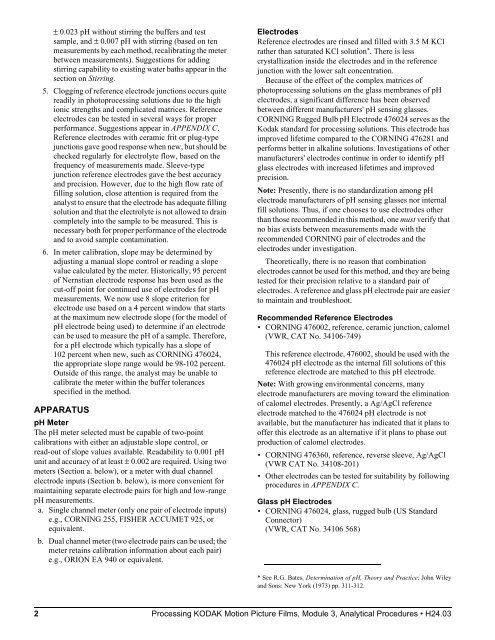Processing kodak motion picture films, module 3 analytical procedures
Processing kodak motion picture films, module 3 analytical procedures
Processing kodak motion picture films, module 3 analytical procedures
You also want an ePaper? Increase the reach of your titles
YUMPU automatically turns print PDFs into web optimized ePapers that Google loves.
± 0.023 pH without stirring the buffers and test<br />
sample, and ± 0.007 pH with stirring (based on ten<br />
measurements by each method, recalibrating the meter<br />
between measurements). Suggestions for adding<br />
stirring capability to existing water baths appear in the<br />
section on Stirring.<br />
5. Clogging of reference electrode junctions occurs quite<br />
readily in photoprocessing solutions due to the high<br />
ionic strengths and complicated matrices. Reference<br />
electrodes can be tested in several ways for proper<br />
performance. Suggestions appear in APPENDIX C.<br />
Reference electrodes with ceramic frit or plug-type<br />
junctions gave good response when new, but should be<br />
checked regularly for electrolyte flow, based on the<br />
frequency of measurements made. Sleeve-type<br />
junction reference electrodes gave the best accuracy<br />
and precision. However, due to the high flow rate of<br />
filling solution, close attention is required from the<br />
analyst to ensure that the electrode has adequate filling<br />
solution and that the electrolyte is not allowed to drain<br />
completely into the sample to be measured. This is<br />
necessary both for proper performance of the electrode<br />
and to avoid sample contamination.<br />
6. In meter calibration, slope may be determined by<br />
adjusting a manual slope control or reading a slope<br />
value calculated by the meter. Historically, 95 percent<br />
of Nernstian electrode response has been used as the<br />
cut-off point for continued use of electrodes for pH<br />
measurements. We now use 8 slope criterion for<br />
electrode use based on a 4 percent window that starts<br />
at the maximum new electrode slope (for the model of<br />
pH electrode being used) to determine if an electrode<br />
can be used to measure the pH of a sample. Therefore,<br />
for a pH electrode which typically has a slope of<br />
102 percent when new, such as CORNING 476024,<br />
the appropriate slope range would be 98-102 percent.<br />
Outside of this range, the analyst may be unable to<br />
calibrate the meter within the buffer tolerances<br />
specified in the method.<br />
APPARATUS<br />
pH Meter<br />
The pH meter selected must be capable of two-point<br />
calibrations with either an adjustable slope control, or<br />
read-out of slope values available. Readability to 0.001 pH<br />
unit and accuracy of at least ± 0.002 are required. Using two<br />
meters (Section a. below), or a meter with dual channel<br />
electrode inputs (Section b. below), is more convenient for<br />
maintaining separate electrode pairs for high and low-range<br />
pH measurements.<br />
a. Single channel meter (only one pair of electrode inputs)<br />
e.g., CORNING 255, FISHER ACCUMET 925, or<br />
equivalent.<br />
b. Dual channel meter (two electrode pairs can be used; the<br />
meter retains calibration information about each pair)<br />
e.g., ORION EA 940 or equivalent.<br />
Electrodes<br />
Reference electrodes are rinsed and filled with 3.5 M KCl<br />
rather than saturated KCl solution *. There is less<br />
crystallization inside the electrodes and in the reference<br />
junction with the lower salt concentration.<br />
Because of the effect of the complex matrices of<br />
photoprocessing solutions on the glass membranes of pH<br />
electrodes, a significant difference has been observed<br />
between different manufacturers' pH sensing glasses.<br />
CORNING Rugged Bulb pH Electrode 476024 serves as the<br />
Kodak standard for processing solutions. This electrode has<br />
improved lifetime compared to the CORNING 476281 and<br />
performs better in alkaline solutions. Investigations of other<br />
manufacturers' electrodes continue in order to identify pH<br />
glass electrodes with increased lifetimes and improved<br />
precision.<br />
Note: Presently, there is no standardization among pH<br />
electrode manufacturers of pH sensing glasses nor internal<br />
fill solutions. Thus, if one chooses to use electrodes other<br />
than those recommended in this method, one must verify that<br />
no bias exists between measurements made with the<br />
recommended CORNING pair of electrodes and the<br />
electrodes under investigation.<br />
Theoretically, there is no reason that combination<br />
electrodes cannot be used for this method, and they are being<br />
tested for their precision relative to a standard pair of<br />
electrodes. A reference and glass pH electrode pair are easier<br />
to maintain and troubleshoot.<br />
Recommended Reference Electrodes<br />
CORNING 476002, reference, ceramic junction, calomel<br />
(VWR, CAT No. 34106-749)<br />
This reference electrode, 476002, should be used with the<br />
476024 pH electrode as the internal fill solutions of this<br />
reference electrode are matched to this pH electrode.<br />
Note: With growing environmental concerns, many<br />
electrode manufacturers are moving toward the elimination<br />
of calomel electrodes. Presently, a Ag/AgCl reference<br />
electrode matched to the 476024 pH electrode is not<br />
available, but the manufacturer has indicated that it plans to<br />
offer this electrode as an alternative if it plans to phase out<br />
production of calomel electrodes.<br />
CORNING 476360, reference, reverse sleeve, Ag/AgCl<br />
(VWR CAT No. 34108-201)<br />
Other electrodes can be tested for suitability by following<br />
<strong>procedures</strong> in APPENDIX C.<br />
Glass pH Electrodes<br />
CORNING 476024, glass, rugged bulb (US Standard<br />
Connector)<br />
(VWR, CAT No. 34106 568)<br />
* See R.G. Bates, Determination of pH, Theory and Practice; John Wiley<br />
and Sons: New York (1973) pp. 311-312.<br />
2 <strong>Processing</strong> KODAK Motion Picture Films, Module 3, Analytical Procedures H24.03
















